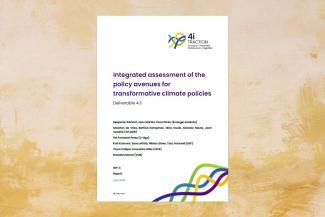
Görlach, Benajmin et al. (2024): Integrated assessment of the policy avenues for transformative climate policies. 4i-TRACTION Deliverable 4.3. Ecologic Institut, Berlin
Integrated assessment of the policy avenues for transformative climate policies
This report assesses the ability of four different policy avenues to address the transformative challenges of innovation, investment, infrastructure, and integration.
There are diverse approaches to climate policy that are based on different perceptions of the nature of the problem that needs to be solved and that rely on different policy instruments and governance frameworks to do so. This report presents an integrated assessment of four “policy avenues” (PA) – different combinations of policy instruments that reflect such distinct approaches to the design of climate policy, that 4i-TRACTION developed in a previous report. They are all geared at achieving climate neutrality in the EU, but differ in the choice of instruments and in their underlying regulatory philosophy. The aim of the report is to understand the respective PA’s ability to address the transformation challenges of innovation, investment, infrastructure, and integration – the 4 i’s – and derive insights for the EU’s climate policy mix going forward.
Transformation Gaps to Climate Neutrality
Gaps still exist in the EU’s climate policy for addressing the transformation challenges of innovation, investment, infrastructure, and integration on the way to climate neutrality. The table below provides an overview of the gaps that still exist in policy and action across the 4i challenges. These transformation gaps are discussed in detail in chapter 2 of the report.
EU climate policy reflects different ideas and interests over time
EU climate policy has been influenced by different paradigms of policymaking. Developing out of a command-and-control EU environmental policy, EU policy has been prominently influenced by economic liberalism resulting in the dominance of market-based policy instruments. However, the EU’s climate policy mix continues to also rely on planning and direct regulatory instruments. Increasingly, the EU employs elements of industrial policy to transform its economy, such as technology support tools and incentives for investment. Largely absent from the EU’s policy are instruments that explicitly address sufficiency and lifestyle changes, instruments most associated with the policy paradigm of sufficiency and degrowth.
The main part of the report presents an integrated assessment of the four policy avenues that were developed in a previous 4i-TRACTION report.
In short: how do the Policy Avenues perform?
While the results are mixed and should be interpreted with caution, some general patters become evident:
- The assessment of the different PA’s and their suitability for transformative climate policy finds that neither of the four avenues would offer a superior approach to address the combined transformation challenges of innovation, investment, infrastructure, and integration. The assessment reveals strengths and weaknesses of the different policy avenues and suggests aspects where some avenues are better suited than others.
- Overall, Green Industrial Policy shows comparative strengths, especially due to its relatively strong performance on tackling innovation, investment, and infrastructure. This is primarily because of the policy avenue’s explicit focus on directing and supporting technological change through different mechanisms (economic incentives, planning, and regulation). However, the approach is assessed as weak on political attainability, given its reliance on public investments and high demands for state capacity.
- The PA of Green Economic Liberalism is strong in the deployment of market-ready innovations and disincentivising fossil-based technologies. While it is less strong on tackling the infrastructure challenge, its relatively low demands for state capacity and planning may be a comparative strength. The Directed Transition policy avenue is strong in providing directionality and planning, but weak when it comes to mobilising investments and dynamic incentives.
Key conclusions and recommendations for EU climate policy
- Evolution instead of revolution: A “pure” policy mix that is exclusively organised around a single policy paradigm would require a fundamental overhaul of EU climate policy. This seems politically unrealistic, risky, and would take several years to agree and implement. Moreover, while following a single policy paradigm may be more consistent, it is unclear if it will be more effective and efficient. Therefore, the more promising route is evolving the current mix by incorporating elements of the different PA’s.
- Green industrial policy will be necessary to drive the development of new technological solutions and lead them to market maturity, to close the investment gap, to facilitate the emergence of business models, and to coordinate the joint deployment of the infrastructure that is needed to support the emerging innovations.
- Elements of economic liberalism, such as the ETS and other market-based instruments, are essential for the efficient deployment of climate-neutral alternatives when technologies have become market-ready and when other non-price barriers have been addressed. The EU must stay course in their emissions trading policy.
- Elements of direct regulation are important for providing directionality throughout the process and clarity where possible. Such policies serve to provide strategic planning and overarching coordination. This also relates to determining which types of infrastructure will become available where, and thereby enables or precludes certain mitigation options.
- Sufficiency and lifestyle changes will be needed to address those decarbonisation challenges where no suitable (technological) alternatives can be foreseen, or where rebound effects threaten to erode technological gains. For some emission sources, for which technological solutions are unlikely to materialise (such as meat consumption or long-distance travel), it seems inevitable that a part of the solution would involve changing lifestyles and consumption behaviour.
- The mix of these approaches will evolve over time, emphasising different elements in different stages. In the near term, industrial policy and innovation support are needed to develop technological alternatives and make them cost competitive. Market-based instruments will continue to play a central role in diffusing alternatives. Coordination and planning will be essential to direct long-term change and provide a vision, not least for developing the needed infrastructure. In the long term, lifestyle changes are needed, especially for those areas where technological alternatives will be unavailable or insufficient.
Download the report here (PDF).